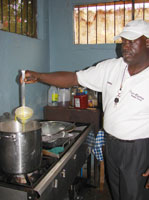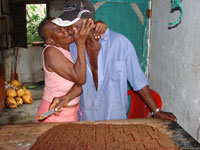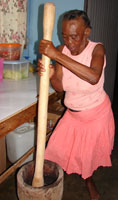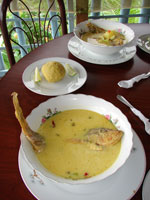Getting a taste of Honduras, Garifuna-style
This item appears on page 72 of the July 2009 issue.
by Sandra Scott
Orel Emile Gentle Steward traded his life as a chef on a cruise ship to be a chef in his hometown of Sambo Creek, Honduras.
Sambo Creek is one of many colorful Garifuna villages that dot the north coast of Honduras. The Garifuna are an AfroCaribbean group which lives on some of the most beautiful palm-fringed beaches in Central America. It is easy to understand why Chef Orel returned to Sambo Creek.
The Garifuna originated from two Spanish slave ships wrecked off the coast of St. Vincent in the 1600s. Their culture is so unique that in 2001 UNESCO proclaimed their language, dance and music a Masterpiece of the Oral and Intangible Heritage of Humanity. They are widely known for their wonderful seafood dishes that are an integral expression of their culture.
In Sambo Creek, only a short ride from La Ceiba, Chef Orel explained, “The Garifuna live off the ocean. Every day the people go fishing.”
He proceeded to teach my husband, John, and me how to make sopa de pescado (fish soup) with machuca. His neighbor, Hoga Lalyn Fermana, helped prepare the machuca by pounding the plantain in a traditional wooden mortar with a long-handled pestle. While doing so, she danced the punta, the Garifuna traditional dance. The two seemed very closely associated in rhythm and movement. Machuca is served like rice or mashed potatoes.
We were enjoying the soup and machuca when a couple of the local people showed up with their drums and began to beat out a rhythm while dancing the punta.
“We look for any excuse to sing and dance,” explained Chef Orel as he pointed to the children on the beach who heard the drums and were doing their very best punta.
Chef Orel glanced down from the second floor of the restaurant at his neighbor’s house and said, “Come with me. Hoga is making a coconut candy. She will teach you how to make it. Hoga is everyone’s grandma.”
The talbeta de coco Hoga had just finished making was cooling and hardening on the table, but she showed us how she grated coconut and cooked it with cane syrup, stirring with a wooden spatula until it stuck together.
Her husband, whom she grabbed and gave a great big kiss, was cutting the sweet into serving-size portions. The big kiss seemed the perfect end to our visit.
We visited Sambo Creek in October ’08, having made our arrangements to visit the town with Tourist Options (Boulevard 15 de Septiembre, La Ceiba, Honduras; phone [504] 443 0337, fax 443 2460, www.hondurastouristoptions.com). The travel agency is located two blocks from La Ceiba’s Central Park. The tour cost us $27 and included transportation, entertainment, an awesome meal and a taste of Garifuna culture.
1/4 teaspoon salt
2 yellow plantains, peeled and cubed
2 green plantains, peeled and cubed
Boil the plantains with a pinch of salt until soft.
Mash together until it’s similar to mashed potatoes. (Traditionally, it is mashed African style with a long wooden pestle in a wooden mortar.)
Serve it on the side with the fish soup.
salt and other seasonings to taste
1 cubed yucca (or potato)
1 sliced onion
1 cup coconut milk
4 cups fish stock made from scratch. (Canned fish, chicken or vegetable stock can be substituted.)
2 crushed cloves of garlic
one diced sweet pepper
1 whole fish, about 9 inches in length, per serving or skinned fish meat cut in cubes. (The Garifuna use red snapper, yellowtail or king fish, but any fish will do.)
To the stock add onions, sweet pepper, salt and any desired spices. Give it a little kick with jalapeño peppers. Add the yucca (or potatoes), sliced onions and coconut milk. Cook until the yucca is tender.
Fry the fish or boil it in the stock for 7 minutes.
If the fish is fried, place it in a bowl and pour the liquid over it. Serve with machuca on the side and a few slices of lemon. Traditionally, when serving the soup to females the tail is cut off. Each chef has his own “secret” ingredients. We chatted with a chef in another Garifuna village and he said he likes to add cumin and to fry the fish and vegetables in butter before adding it to the stock.
(makes 2 to 4 servings)




